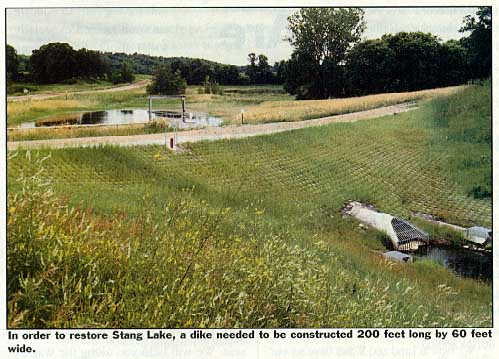The Rebirth of Stang Lakeby Rocky Waldin |
 After sitting dry for almost 89 years, Stang Lake, located five miles east of Fergus Falls, Minnesota, is being given new life by the U.S. Fish & Wildlife Service (FWS). A construction project was completed in late 1996 that will restore the Stang Lake wetland area to much of what is was like in the late 1800's - a refuge for wildlife of all kinds. The waters of the lake are once again rising, although in a controlled manner to maximize acceptance by surrounding vegetation and wildlife. The inspiration for this project was born on November 4, 1908. That was the day that Stang Lake "disappeared". A small ditch was being dug to install an over-flow pipe in the lakeside embankment to maintain the lake level. The pipe was to be installed and the ditch refilled. One too many shovelfuls of the sandy soil was removed, and the ditch gave way to the onslaught of water. Stang Lake, almost two miles long and up to a mile wide, was drained dry in less than an hour. The ditch opened to a width of over 200 feet, taking with it full grown oak trees and a granary containing 1500 bushels of wheat. The water moved more than a mile west, into Wall Lake. Local farmers went to the drained lake bottom and shoveled wagonloads of stranded fish. The area never became productive, being too dry to attract wildlife and too wet to farm. The idea of restoring the lake had been kicked around for decades. In the early 80's, Bernard Eggen, a landowner along the former lake, proposed diking up the western end of the old lakebed, but local property owners were not receptive. When he approached the Fish & Wildlife Service with the idea again in the early 90's, attitudes had changed. Adjacent landowners were interested in creating wildlife habitat, and eventually all 29 landowners that would be impacted by the project signed the perpetual easement. The landowners were willing to have water cover their share of the lake bottom; if only one landowner had protested, no work could have been done. Now they could proceed with the project! The construction project has been a complicated challenge. It included raising a county road 8 feet, building a dike 200 feet long by 60 feet wide and constructing a water control structure. The project was awarded to the Delzer Construction Company, Dalton, MN, in July of 1995. Work was started in August with the excavation of the area where the dam would be built. Soils were cleared down to 20' below the watertable, where a bentonite/cement slurry wall was poured, 2 feet thick by 25 feet deep by 150 feet long. Yellow clay was then brought from a nearby borrow site to construct the body of the dam. ABC Construction began the construction of the water control structure, a poured-in-place structure utilizing stop-logs to control the upstream water level and subsequent downstream flow through a 60" concrete pipe under the dam and outletting into County Ditch #27. This control structure must accommodate excess flows from the surrounding 5000-acre watershed. The downstream side of the dam was protected with Cable Concrete, an articulating concrete mat system sold by International Erosion Control Systems, Stacy, MN, and manufactured by Concrete Sectional Culvert Company, Fargo, ND. Dirt was placed between the Cable Concrete and seeded with native grass. The area was then covered with wood fiber blanket for temporary eroison control. Straw mulch was placed on the other areas and bale checks were installed to control water runoff. The wood fiber blanket was sold by PPS Packaging of Fowler, California and manufactured by Western Excelsior in Mancuos, Colorado. In late 1996, the project was completed, with the entire site groomed and seeded by Lawn and Driveway Service, Morris, MN. The stoplogs were added to the control structure in March of this year, and Stang Lake began to grow again! Snowmelt from last winter's record snowfalls served to "jumpstart" the filling of the lake. The restoration of Stang Lake will improve the overall water quality of the water flowing into nearby Wall Lake, and eventually into the Ottertail River and Red River. Jim Piehl, wildlife biologist for the FWS in neighboring Fergus Falls, is the man in charge of restoring this 300-acre wetland. According to Jim, the lake will not be allowed to return to its historical depth of up to 30', but instead it will be restored to a level that will maximize its value to a variety of wildlife species. The eastern portion will be relatively shallow, with abundant stands of cattails providing valuable habitat for pheasants, deer, migrating birds and nesting waterfowl. Aquatic plants in the lake have recolonized on their own quite successfully. Deep water marsh will dominate the western portion, attracting migrating waterfowl and other wetland wildlife. For the outdoor enthusiasts, the lake will be open for hunting and trapping. The project was funded by the U.S. Fish & Wildlife Service, Ducks Unlimited and local conservation organizations at a cost of $750,000. While wetland restoration projects are a high priority for the FWS, most are on a much smaller scale, affecting 5 to 35 acres. Sam Marler, FWS Regional Director, said this restoration project is one of the largest of its kind in the country and "will be one of the best, if not the best, such project in America". For more information, contact Rocky Waldin, Independent Sales Agent for International Erosion Control Systems, 7100 Utica Lane, Chanhassen, MN 55317, (612)860-0803, fax (612)470-0342, E-mail: rockyw@minn.net. |
©2000, 1999, 1998 Land and Water, Inc.